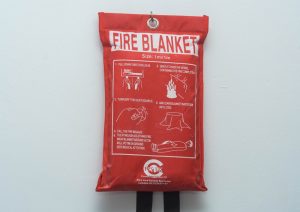
What Should a Fire Blanket Be Used For?
A fire blanket is used when a person is on fire as well as any fire that can be fully covered. A fire blanket, however, should not be used on a fire involving lithium-ion batteries - these can be found on phones, ipads, wireless headphones etc.What Should a Fire Blanket Be Used For?
A fire blanket is a vital piece of safety equipment designed to extinguish small fires by depriving them of oxygen. It’s a simple yet effective tool that can make a significant difference in a fire emergency. While its primary purpose is clear, there are nuances to its use, limitations, and specific applications that warrant a deeper understanding.
Understanding the Fire Triangle
To fully appreciate the role of a fire blanket, it’s essential to grasp the concept of the fire triangle. A fire requires three elements to ignite and sustain itself: heat, fuel, and oxygen. By removing any one of these elements, you can extinguish the fire. A fire blanket primarily works by cutting off the oxygen supply, effectively suffocating the flames.
Primary Uses of a Fire Blanket
- Kitchen Fires: This is arguably the most common application. Kitchen fires, especially those involving cooking oils and fats, can escalate rapidly. By covering the burning pan or pot, you deprive the fire of oxygen, allowing it to suffocate. It’s crucial to remember that water should never be used on oil or grease fires as it can cause the flames to spread.
- Clothing Fires: If someone’s clothing catches fire, a blanket can be a lifesaver. By wrapping the person in the blanket, you smother the flames and prevent them from spreading. It’s essential to lay the person down and roll them in the blanket to extinguish the fire effectively.
- Waste Bin Fires: Small fires in waste bins can be quickly contained and extinguished using a blanket. By covering the bin entirely, you cut off the oxygen supply and prevent the fire from spreading.
Limitations of a Fire Blanket
While fire blankets are invaluable tools, they have limitations. They are designed for small fires and are not suitable for large-scale blazes. For larger fires, evacuate the area immediately and call the fire department. Additionally, fire blankets are not effective against all types of fires, such as those involving electrical equipment.
Other Potential Uses
Beyond its primary applications, it can be used in other situations:
- Campfires: In camping or outdoor settings, they can be used to smother small campfires or to create a windbreak.
- Emergency Blankets: Some fire blankets are designed to be used as emergency blankets to provide warmth and protection in cold conditions.
- Smoke and Fumes: In case of a fire, it can be used to create a barrier against smoke and fumes, making it easier to escape the building.
Choosing and Maintaining a Fire Blanket
When selecting a fire blanket, ensure it meets the appropriate safety standards. Look for blankets made from fire-resistant materials and that are large enough to cover the potential fire source. Store it in a clearly marked and easily accessible location. Regularly inspect the blanket for any signs of damage or wear and replace it if necessary.
How to Use a Fire Blanket
Using it correctly is crucial. Follow these steps:
- Stay Calm: Panic can hinder your ability to respond effectively.
- Assess the Situation: Determine if the fire is small enough to be extinguished with a blanket.
- Evacuate if Necessary: If the fire is too large or spreading rapidly, evacuate immediately and call the fire department.
- Grab the Blanket: Remove it from its storage container.
- Cover the Fire: Approach the fire from the side and quickly cover it. Hold the blanket in place until you are confident the fire is completely out.
- Evacuate: Once the fire is extinguished, evacuate the area and ventilate it properly.
Remember, it is a tool, not a guarantee of safety. It’s essential to combine its use with other fire safety measures, such as having working smoke alarms, developing a fire escape plan, and practicing fire drills.
By understanding the capabilities and limitations, you can increase your chances of responding effectively to a fire emergency and protecting yourself and others.
For more information on Fire Blanket Safety contact Total Safe UK.
